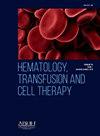静脉注射免疫球蛋白对治疗 Rh 型和 ABO 型新生儿溶血病的影响
IF 1.8
Q3 HEMATOLOGY
引用次数: 0
摘要
鉴于新生儿高胆红素血症与病理性黄疸的发生密切相关,是神经毒性和核黄疸的原因之一,本研究旨在评估静脉注射免疫球蛋白(IVIG)在新生儿高胆红素血症中的应用。方法对O型血母亲及其ABO、Rh血型新生儿进行回顾性病例对照研究。回顾了2017年至2020年79例新生儿溶血性疾病(HDN)患者的总血清胆红素水平的医疗记录。根据美国儿科学会(AAP)的指导方针,有资格接受免疫球蛋白治疗的新生儿被归类为病例,其余的被纳入对照组。结果ivig组新生儿的平均总胆红素与血红蛋白水平显著低于非ivig组(13.98±4.23 mg/dL vs 16.61±2.68 mg/dL;p值= 0.002)。尽管女性在ivig治疗组的住院时间更长(3.81±1.28天和3.54±1.30天);p值= 0.509)和非ivig组(3.43±0.811天和3.19±0.75天;p值= 0.361)组与男性相比,组间差异无统计学意义。虽然4名ABO血型不合的新生儿需要填充红细胞,但所有婴儿都得到了医学治疗,在治疗过程中没有发生死亡。此外,没有观察到换血或IVIG的不良反应。结论本研究结果显示IVIG是治疗胆红素脑病的有效方法,更有机会减少新生儿高胆红素血症的交换输血需求。本文章由计算机程序翻译,如有差异,请以英文原文为准。
Effect of intravenous immunoglobulin on the management of Rh- and ABO-mediated hemolytic disease of the newborn
Background
Regarding the close association between neonatal hyperbilirubinemia and occurrence of pathological jaundice as a cause of neurotoxicity and kernicterus, the present study aimed to evaluate the use of intravenous immunoglobulin (IVIG) in neonates with hyperbilirubinemia.
Methods
A retrospective case-control study of blood group O mothers and their ABO and Rh newborns was conducted. Medical records that included total serum bilirubin levels of 79 patients with hemolytic disease of the newborn (HDN) from between 2017 and 2020 were reviewed. Neonates who were eligible to receive immunoglobulin based on the American Academy of Pediatrics (AAP) guidelines were classified as cases and the rest were included as the Control Group.
Results
The mean total bilirubin in relation to hemoglobin levels in IVIG-treated neonates was significantly lower than in non-IVIG-treated neonates (13.98 ± 4.23 mg/dL versus 16.61 ± 2.68 mg/dL; p-value = 0.002). Although females had longer hospitalizations in both IVIG-treated (3.81 ± 1.28 versus 3.54 ± 1.30 days; p-value = 0.509) and non-IVIG-treated (3.43 ± 0.811 versus 3.19 ± 0.75 days; p-value = 0.361) groups compared to males, this difference was not significant between the groups. Although four neonates with ABO incompatibility required packed red blood cells, all infants were managed medically and no deaths occurred during the course of treatment. Moreover, no exchange transfusion or adverse effects of IVIG were observed.
Conclusion
The results from the present study revealed that IVIG administration is a useful procedure for the management of bilirubin encephalopathy with greater opportunity to reduce exchange transfusion requirements for neonatal hyperbilirubinemia.
求助全文
通过发布文献求助,成功后即可免费获取论文全文。
去求助
来源期刊

Hematology, Transfusion and Cell Therapy
Multiple-
CiteScore
2.40
自引率
4.80%
发文量
1419
审稿时长
30 weeks
 求助内容:
求助内容: 应助结果提醒方式:
应助结果提醒方式:


